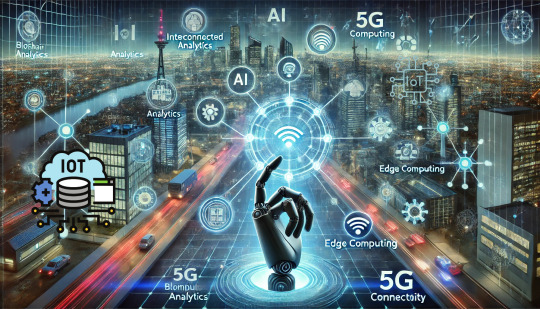#DigitaltwinsinIoT
Explore tagged Tumblr posts
Text

#EmergingIOTtechnologies#AI in IoT#Edge computing in IoT#5G and IoT growth#IoT cybersecurity solutions#DigitaltwinsinIoT
0 notes
Text
The Future of IoT Services: Innovations, Technologies & Growth Opportunities
The Internet of Things (IoT) is evolving rapidly, transforming industries and opening new opportunities for developers, service providers, decision-makers, and market leaders. With smart connectivity, automation, and AI integration, IoT is becoming an essential part of various sectors, from healthcare and manufacturing to smart cities and retail. This article explores the latest trends, emerging technologies, and key aspects that anyone entering this field should know.
Latest Trends Transforming IoT Services
IoT is rapidly evolving, bringing groundbreaking innovations that enhance automation, security, and data-driven decision-making. Here are the key trends shaping the future of IoT:
1. AI-Enhanced IoT: Making Smart Systems Smarter
Artificial Intelligence (AI) is revolutionizing IoT by enabling real-time analytics, predictive maintenance, and autonomous decision-making. AI-powered IoT devices can process data more efficiently, optimize workflows, and reduce downtime. Smart factories, healthcare monitoring, and intelligent traffic systems benefit from AI-driven IoT solutions.
2. Edge Computing: Real-Time Data Processing at the Source
Latency has always been a challenge in IoT networks. Edge computing reduces dependence on centralized cloud servers by processing data closer to the source. This results in faster decision-making, improved security, and cost savings in applications like autonomous vehicles, industrial automation, and remote healthcare monitoring.
3. 5G Integration: Expanding the Potential of IoT
5G is a game-changer for IoT. It offers ultra-fast connectivity, low latency, and increased bandwidth, allowing seamless communication between billions of connected devices. Applications such as smart grids, smart cities, and telemedicine will see exponential growth with 5G-enabled IoT solutions.
4. IoT Security and Zero Trust Architecture
With the growing number of connected devices, security remains a top priority. Zero Trust Architecture (ZTA) and Blockchain-based security frameworks ensure encrypted communication, secure device authentication, and protection against cyber threats. Companies are investing in multi-layered security solutions to safeguard IoT ecosystems.
5. Digital Twin Technology: Bridging the Physical and Virtual Worlds
Digital Twins create virtual replicas of physical assets, enabling real-time monitoring, simulation, and predictive analytics. Industries like manufacturing, logistics, and healthcare use this technology to improve efficiency, reduce maintenance costs, and enhance product development.
Key Technologies Driving IoT Growth
1. LPWANs (Low-Power Wide-Area Networks) for Scalable IoT Solutions
LPWANs like LoRaWAN, Sigfox, and NB-IoT enable long-range communication with minimal power consumption. These networks are ideal for large-scale applications such as smart agriculture, environmental monitoring, and industrial asset tracking.
2. Blockchain Integration: Securing IoT Networks
Blockchain technology enhances IoT security by providing decentralized data storage, ensuring transparency, and preventing data breaches. It is being increasingly adopted in supply chain management, smart contracts, and secure data transactions.
3. Next-Gen Smart Sensors: Improving Data Collection & Analysis
Modern smart sensors are designed to collect, process, and analyze data more efficiently. With AI-powered self-calibration and real-time feedback mechanisms, these sensors are used in precision agriculture, smart homes, and automated quality control.
4. IoT-Specific Operating Systems for Better Performance
Traditional operating systems are not optimized for IoT applications. New lightweight and secure IoT-specific operating systems like Zephyr, RIOT, and FreeRTOS are enhancing device performance while minimizing energy consumption.
5. Human-Machine Interaction (HMI) & IoT
The integration of Augmented Reality (AR), Virtual Reality (VR), and advanced voice recognition is making IoT solutions more interactive. AI-powered virtual assistants, gesture-based controls, and AR-driven maintenance tools are transforming how humans interact with connected devices.
A Comprehensive Guide for IoT Enthusiasts
For those looking to step into the IoT field, mastering essential technologies and strategies is crucial. Here’s how to get started:
Understand IoT Architecture: Learn about hardware, networking, cloud computing, and device-to-device communication protocols.
Prioritize Security from Day One: Implement encryption, authentication, and secure coding practices in every IoT solution.
Select the Right Connectivity Protocol: Depending on the use case, choose between MQTT, CoAP, Zigbee, or other IoT communication protocols.
Leverage AI & Big Data: Use machine learning models to extract insights, automate tasks, and enhance predictive data analytics.
Ensure Regulatory Compliance: Stay informed about IoT-specific legal frameworks like GDPR, HIPAA, and industry-specific security guidelines.
The Road Ahead for IoT Services
The rapid evolution of IoT is reshaping industries, unlocking new possibilities for connectivity, automation, and intelligence. With advancements in AI-driven analytics, edge computing, 5G, and enhanced security frameworks, IoT is becoming more robust, efficient, and secure. As digital twin technology, blockchain integration, and next-generation sensors continue to gain traction, the potential applications of IoT will only expand further.
For those looking to thrive in this space, staying informed about emerging technologies, prioritizing security, and choosing the right connectivity solutions are essential. Whether it's optimizing industrial operations, enhancing healthcare systems, or enabling smarter cities, IOT services will play a pivotal role in the digital transformation of the future. Embracing innovation and adaptability will be the key to success in this ever-evolving ecosystem.
As IoT continues to evolve, businesses and developers must stay ahead by embracing IOT services that offer secure, scalable, and innovative solutions. From AI-driven automation to 5G-powered smart systems, the future of IoT is filled with limitless possibilities.
Frequently Asked Questions (FAQs)
1. What are the most critical factors when choosing an IoT service provider?
The key factors include security, scalability, compatibility with existing systems, cloud integration, and customer support.
2. How does IoT enhance operational efficiency?
IoT automates data collection, enables predictive maintenance, and provides real-time analytics, helping organizations optimize resources and reduce costs.
3. What role does AI play in IoT services?
AI enhances IoT by enabling real-time decision-making, automating processes, improving security, and optimizing data analytics for better outcomes.
4. How do IoT networks ensure data privacy?
IoT networks use encryption, tokenization, secure device authentication, and decentralized blockchain systems to protect user data.
5. What are the best connectivity options for IoT applications?
The choice depends on the use case: Wi-Fi and Bluetooth for short-range, LPWAN for large-scale applications, and 5G for ultra-fast, low-latency IoT solutions.
#EmergingIOTtechnologies#AI in IoT#Edge computing in IoT#5G and IoT growth#IoT cybersecurity solutions#DigitaltwinsinIoT#iot#iot solutions
0 notes